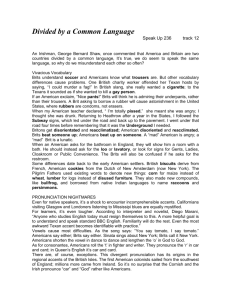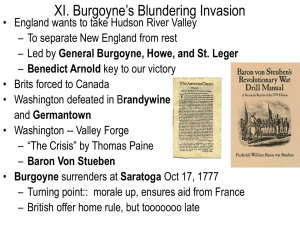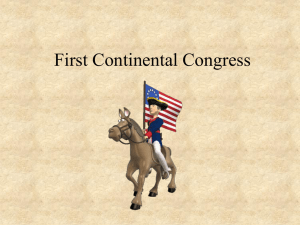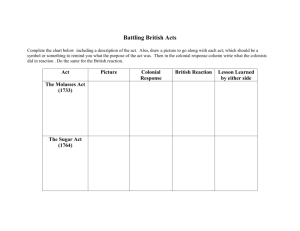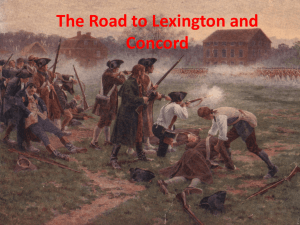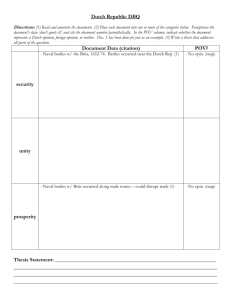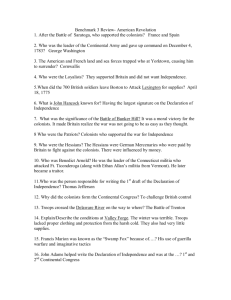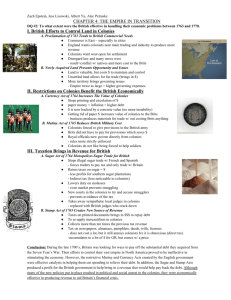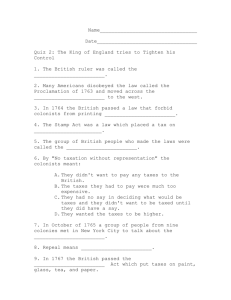The American Revolution
advertisement
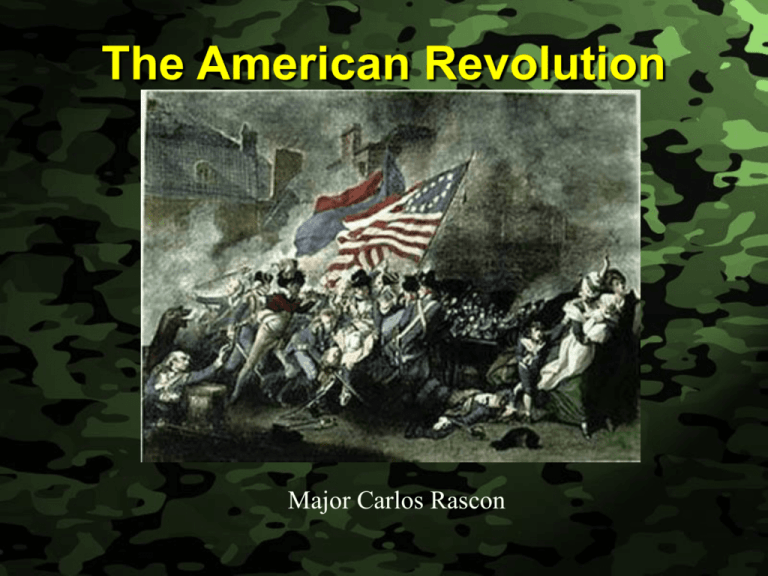
Slide 1 The American Revolution Major Carlos Rascon Slide 2 References Dupuy and Dupuy, The Encyclopedia of Military History, pp. 708-725 Fuller, A Military History of the Western World, Vol. II, Chronicles 9, 10; ch. 9,10; pp. 271-340 Weigley, The American Way of War, pp. 3-39 Slide 3 Learning Objectives Know the U.S. and British strategies and objectives, and how they changed. Be familiar with key campaigns and the policies that contributed to their success. Describe the factors that contributed to the British losses. Describe how the intervention of the French assisted the U.S. Understand the changes in warfare precipitated by the American Revolution. Slide 4 Causes of the War British defeat French in French/Indian War – Defeat of Indians removes colonists’ perceived need for British protection – War costly for Brits and need add’l income Stamp, Navigation, and Revenue Act force colonists to pay for protection 1770 Boston Massacre – 5 dead after protesting taxation w/o representation Slide 5 Causes of the War (cont.) Quartering Act Real Causes – Colonists forced to house British troops – 3rd Amendment of the Constitution – Colonists had intellectual differences with British gov’t – Spirit of independence brought about by frontier life – Belief in democracy over oligarchy Slide 6 Colonial Strategy Partisan warfare through local militia Strategy of attrition – Gradual wear down or weakening – Long lines of comm/supply for English – English resolve is weak – English has enemies in Europe Colonialists split 1/3 rebel, loyalist, and indifferent causing civil war Slide 7 British Strategy Break colonies in half at NYC Economic warfare England’s Royal Navy – Break lines of communication and supply – Separate passion from provision – Blockade – Counterfeiting – Able to move freely along long coastal strip – No critical points to maneuver against Slide 8 Battle of Lexington 19 Apr 1775 •Brits send 700 troops to destroy arms stash in Concord •“Minute Men” meet Brits at Lexington •Eight colonists dead, 10 wounded – American Revolution begins •Buys time to remove arms •Public sentiment becomes strongly anti-British Slide 9 Bunker (Breed’s) Hill Jun 1775 New “Continental Army” takes position on Breed’s Hill British conduct frontal assault – Poor judgement – flanks/rear exposed – 40% casualties for Brits (1,100 dead) Colonials repel two assaults but run out of ammo Slide 10 Results of Bunker Hill Colonists convinced standing army was unnecessary Showed colonial determination Gen Howe forever failed to press victories New colonial tactics: – Simple defensive – Hold at the Hudson Slide 11 Saratoga Oct 1777 Brits only hold NYC, part of RI & Philadelphia Brit plan is to hold on to major city, isolate North, and gain southern sentiment Burgoyne moves south from Canada – Plan to take Albany, NY – Meeting up with Howe in NYC to cut North from South Slide 12 Follies at Saratoga Burgoyne sets off with an overbundance of supplies/equipment – Movement extremely slow (1 mile/day) – Guerillas could easily stay ahead and slow further The success of guerillas led to more partisan support Burgoyne’s forces quickly wore down Delays allow colonials to reinforce and win Slide 13 Significance of Saratoga Turning point of Revolution French enters war, aligning with colonists Brits now move focus to the South Spain and Holland soon join war – British forced to protect its own borders from aggressors – British concerned about about long ocean supply lines Slide 14 Southern Campaign Late 1778 Brits felt there were more loyalists in South Southern resources more valuable Brits win small victories but unable to pacify countryside Greene vs Cornwallis – Greene sacrificed mass for manuever – Smaller forces more easily could live off land – Provided add’l rally points for local militia – Tempted Cornwallis to split his forces Slide 15 Battle of Cowpens 17 Jan 1781 Daniel Morgan – Colonial leader – Very charismatic – Expects only two good shots before falling back – Eliminates unseasoned troops fleeing Numerically equal forces but Americans ¾ militia Colonials envelop Brits with militia and cavalry Brits lose 9/10th of men due to overconfidence Slide 16 Yorktown Cornwallis consolidates forces French defeat British ships at Battle of Capes Americans to front; French to rear Brits surrender 17 Oct 1781 Slide 17 British Forces Classic 18th century European army Loyalty suspect in England – Linear tactics – Well-trained soldiers – English sympathy for colonies – Employment of Hessians (mercenaries) Slide 18 American Forces Most local militia for local defense – Troops often under-trained – Quick to flee under fire Von Steuben becomes IG Length of service impeded tactics – Discipline instilled – little before his tenure – Streamlined musket loading & uniformity – Standardized training – speed and marksmanship Slide 19 Impact of French Anxious to regain international position French repeatedly help American cause: – Loans of money – Use of French ports by American privateers – Protected American vessels near French waters Made English uneasy at home French Navy critical at Yorktown Slide 20 Failures of England Initial plan could have worked Lacked unity of command and comm – Didn’t act with resolution – Adequate forces were never provided – Commanders uncertain of objective – Lord Germain directed from England – Indecisive and slow to act Brits unable to exploit Royal Navy Focused on terrain (cities) instead of enemy Slide 21 Weapons of the Era UNITED STATES – Rifle (minority) • • • • More accurate Longer to reload No bayonet Good guerilla weapon – Musket (majority) – Accurate fire • Hunters • Individual targets BRITISH – Brown Bess musket • Volley fire • No target picked Video 4 min Brown Bess Slide 22 Impact on Warfare Democratization of warfare Changed tactics – “Well regulated” militia – Balanced rights with obligated military service – Impact of “people’s army” fighting for a cause – New concept of total war for total victory – Rifle makes linear tactics difficult – Brits adopt American tactics (cover and concealment) Slide 23 Summary Causes for the war Colonial and British strategies Various battles and tactics English short-comings French contributions Weapons of the Revolution Impact on warfare Video 8min Rifleman Slide 24 Questions?
